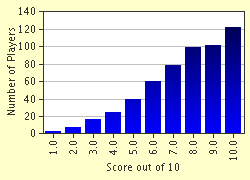Quiz Answer Key and Fun Facts
1. A method of playing an orchestral string instrument. Instead of using the bow, the performer plucks the desired string with a finger.
2. An indication that the tempo of a piece of music should gradually be increased.
3. Slow. An indication of tempo used as a playing direction in music.
4. The notes of a chord played one after another, usually from the bottom upwards.
5. A "little book" that contains the complete text of an opera, oratorio, and so forth.
6. A short 'return' or repetition; a concluding symphony to an air, often consisting of the burden of the song.
7. Literally means "joke." A piece in a lively tempo.
8. In musical notation, it indicates that notes are sounded in a detached and distinctly separate manner with their lengths shortened.
9. Dynamic marking meaning "very soft".
10. A technically extremely accomplished performer/musician.
Source: Author
polpetta2
This quiz was reviewed by FunTrivia editor
bloomsby before going online.
Any errors found in FunTrivia content are routinely corrected through our feedback system.

